The MacBook Pro Review (13 & 15-inch): 2011 Brings Sandy Bridge
by Anand Lal Shimpi, Brian Klug & Vivek Gowri on March 10, 2011 4:17 PM EST- Posted in
- Laptops
- Mac
- Apple
- Intel
- MacBook Pro
- Sandy Bridge
6Gbps SATA
Twenty eight days after Intel launched its Sandy Bridge microprocessors, it announced the stop-shipment of all 6-series Sandy Bridge chipsets. The first shipping version of these chipsets (B2 stepping) was affected by an unfortunate "oversight" that could cause failure in the four 3Gbps SATA ports that branch off the chipset. The remaining two 6Gbps SATA ports were unaffected by the bug.
Most notebooks only use two of the six SATA ports supported by most members of Intel's 6-series chipset family. If a notebook design used the 6Gbps ports exclusively, the notebook would be fine to ship using the flawed B2 stepping parts. With the 3Gbps ports not in use the bug would never show up. Notebooks that used more than just two ports or used at least one of the 3Gbps ports would be affected and would have to be remanufactured with a fixed version of the 6-series chipset. Intel promised to begin shipping fixed (B3 stepping) 6-series chipsets by the end of February.
Apple announced and started selling the 2011 MacBook Pro lineup on February 24, four days before the end of the month. Surely that would be too soon for Apple's manufacturing partners to have received B3 stepping chipsets, built boards around them, integrated them into MacBook Pro designs and shipped them half way across the world to Apple stores all around the US.
Naturally Apple wouldn't comment on what chipset revision was in the 2011 MacBook Pro, so the first thing we did was check to see what SATA ports were in use on our systems.
Here we have the high end 15-inch MacBook Pro. I installed an Intel SSD 510 in the lone 2.5" drive bay and it is connected via a 6Gbps port internally:
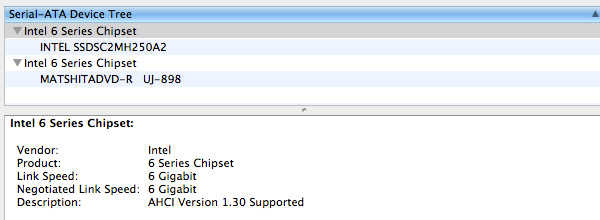
So far, so good. The only other bay in the new MacBook Pro is used for the optical drive. And it's connected to a:
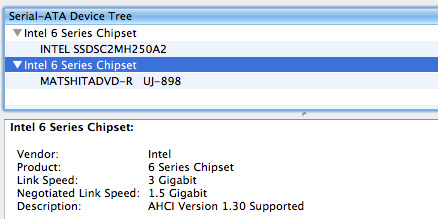
...3Gbps SATA port. Uh-oh.
Apple doesn't directly report chipset IDs under OS X. I installed Windows 7 via Boot Camp and headed over to device manager to pull the device ID of the SATA controller: 1C01.
Cross referencing with Intel's datasheets I found that there are two revisions of the SATA controller: 04 and 05. The latter is used in the "fixed" B3 stepping chipsets. And what do we have here at the end of the hardware ID string for the SATA controller?
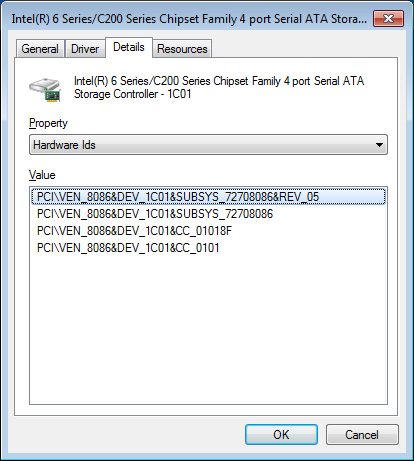
REV_05.
This is a B3 stepping chipset. In fact, Apple's manufacturing partners seem to have received B3 chipsets before anyone else given that boards were produced, tested and shipped in time for a February 24th launch. It would appear that Apple was among the first if not the first company to receive B3 stepping 6-series chipsets. Although I had concern for the health of the Apple/Intel relationship over the past couple of years, it looks like the two are back to being bedfellows.
Internally there are no visible changes to the MacBook Pro's primary SATA cable. It's still a flex cable but apparently capable of delivering twice the bandwidth of last year's model. Apple doesn't ship the new MacBook Pros with any 6Gbps drives and I would be surprised if it selected anything other than Samsung or Toshiba for SSDs, which means even the SSD options are 3Gbps. Luckily I happen to have a small cache of SSDs, including a bunch of new 6Gbps offerings.


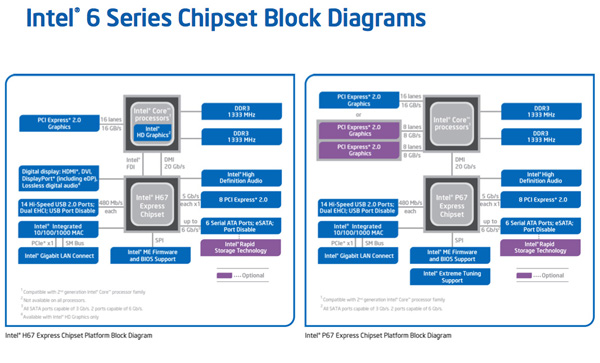
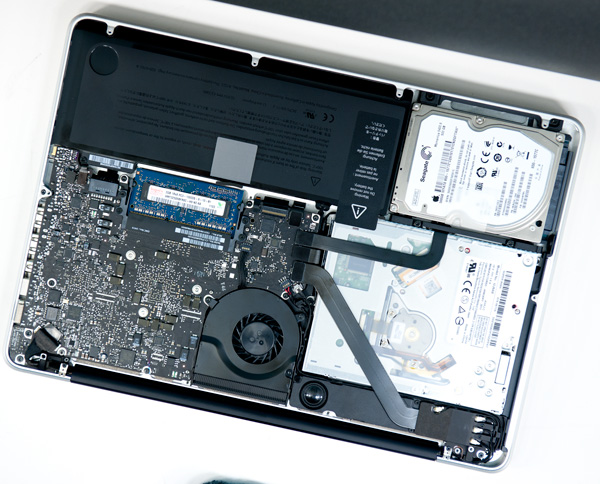








198 Comments
View All Comments
Anand Lal Shimpi - Friday, March 11, 2011 - link
Our top picks right now are either the Intel SSD 510 or something based on the SF-1200 controller (e.g. Corsair Force, OCZ Vertex 2). In the next month or so we should see the first wave of SF-2200 drives hit the market (e.g. OCZ Vertex 3). These things should scream. Keep an eye on our Storage section for new drives as we review them:http://www.anandtech.com/tag/storage
Take care,
Anand
phoible_123 - Thursday, March 10, 2011 - link
I purchased the low-end 13" the day it was released, and am super happy with it. I had been waiting for a while for a suitable upgrade to my 2007 White Macbook. I considered getting the last 15" (almost bought it), but I was worried about heat, size, and weight. Turns out that these concerns were justified, but the Sandy Bridge models seem to be much better.The performance of the new 13" is comparable to the old high-end 15". It is noticeably faster than the last-gen 13" (I have one of those at work). I don't really play games on my laptop, so I don't care about graphics (I have a desktop with a GTX460 at home hooked up to my HDTV).
I have played with all of the other laptops, and the build quality on the Macbook is just better than anything else I've seen. No question about it. Every time someone raves about some other laptop, I go to Best Buy and play with it, and I'm always disappointed (usually the keyboard and/or trackpad sucks, or the case is too flexy).
Sure, I could get a faster laptop for less money, but it wouldn't be as good at what i actually use it for (mostly software development). I got the low-end 13", and will use the money I saved to buy an Optibay and 128GB SSD (already upgraded the RAM to 8GB). The only laptop that could potentially beat it is the forthcoming MBA.
kigoi - Thursday, March 10, 2011 - link
ah except for when i bought it this is how it's gone for me too. and except for waiting to max memory if usage needs it. and maybe hoping for a slicker hybrid hard drive solution, something like the momentus xt but with more cache and a variable spindle.i wonder if the i5 model runs cooler than the i7. we stressed it with handbrake, experienced the fan, felt the underside. it didn't seem to get intolerably hot underneath unless there was zero airflow (like, on a bedcover).
oh btw here is a document of the hidden keyboard secrets of the fn key.
http://pludk.wordpress.com/2011/03/08/happy-accide...
kigoi - Friday, March 11, 2011 - link
oops error. the return of the hidden keypad was actually done by a software extension w/o my knowing. pretty thrilling to report that though, while it lasted.kanaka - Thursday, March 10, 2011 - link
I got my 15" AG yesterday and one of the first things i was impressed with was how sturdier the hing was compared to my existing Late 08 model.owbert - Thursday, March 10, 2011 - link
what is the trade offs between high res antiglare option and high (glossy) res display?kanaka - Thursday, March 10, 2011 - link
Glare vs no glare. Also colours are more saturated on the glossy screen. There's also a slight weight difference due to the glass vs no glass situation.mino - Thursday, March 10, 2011 - link
Simple: you trade "Bling!" for usability.gstrickler - Thursday, March 10, 2011 - link
More brightness and color saturation on the glossy screen, but more money better color accuracy, reduced glare, and slightly lower wright on the matte screen. The matte screen is also higher resolution than the standard screen, but you can get the hires screen in glossy or matte.One side benefit of the matte screen, in environments where glare may be a problem on the glossy screen (e.g. The Apple Store, many offices, etc), I find it's necessary to turn up the screen brightness on the glossy to overpower the glare. With the matte screen, I can use a lower screen brightness, which means less power, and better battery life. I'm not sure how much difference since I don't have a MBP with a glossy screen to perform a side by side test, but I estimate it at 15-30 mins.
dwade123 - Thursday, March 10, 2011 - link
The new Sony S is better.